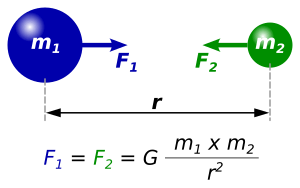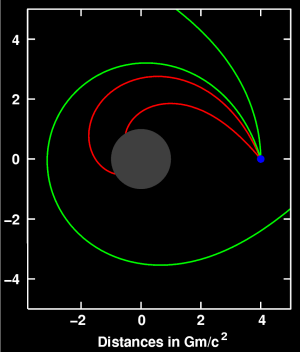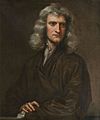Gravity facts for kids
Gravity is one of the main forces of the universe. It's the invisible pull that makes things fall to the ground. It also keeps planets orbiting the Sun and holds galaxies together. Scientists have studied gravity for a long time. We'll explore how we experience gravity every day, how Isaac Newton explained it, and how Albert Einstein later gave us an even deeper understanding with his theory of general relativity.
Some scientists think gravity might be caused by tiny particles called gravitons, but they are still doing research to be sure.
Contents
Everyday Gravity
Weight and Mass
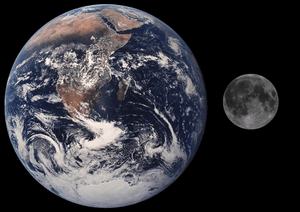
When we talk about things falling, we say the Earth's gravity pulls them down. We often use the words "weight" and "mass" as if they mean the same thing, but they are different!
Your weight changes depending on how strong gravity is. For example, the Moon is much smaller than Earth. The Moon's gravity is about one-sixth of Earth's gravity. So, if you were on the Moon, you would weigh only one-sixth of what you weigh on Earth!
However, your mass stays the same no matter where you are. Mass is the amount of "stuff" or matter in an object. A bowling ball has the same amount of matter on Earth as it does on the Moon. So, its mass doesn't change.
Here are two important ideas:
- Your weight can change, but your mass always stays the same.
- The strength of gravity depends on the mass of an object. The Earth pulls things more strongly than the Moon because it has much more mass. Even you have a tiny gravitational pull, but it's so small we don't notice it.
Every object with mass has a gravitational pull. The Earth pulls on you, and you pull on the Earth! Gravity pulls on an object's mass, which gives it weight.
How Fast Things Fall
When an object falls because of gravity, it speeds up. This speeding up is called acceleration due to gravity. On Earth, we use the letter g to represent this acceleration.
Why Heavier Objects Don't Fall Faster
It might seem like heavier objects should fall faster than lighter ones, but that's not true! Isaac Newton figured out that the force pulling an object down is equal to its mass multiplied by its acceleration.
A heavier object has a greater gravitational force pulling it. But because it also has more mass, that extra mass cancels out the stronger pull. This means all objects, heavy or light, fall at the same speed if only gravity is acting on them.
To see this clearly, you need to remove air from the room (create a vacuum). If you drop a feather and a bowling ball in a vacuum, they will hit the ground at the exact same time! This is because there's no air resistance to slow the feather down.
Gravity vs. Gravitation
In everyday talk, "gravity" and "gravitation" mean almost the same thing. Sometimes, scientists use "gravity" to talk about the actual force that pulls objects together. They use "gravitation" when they are talking about the scientific theory that explains this attraction.
History of Gravity Theories
For centuries, people wondered about gravity. Here's how our understanding grew:
Galileo's Experiments
In the late 1500s, an Italian scientist named Galileo Galilei did famous experiments. He dropped different weighted balls from the Leaning Tower of Pisa. He also rolled balls down ramps. Galileo showed that gravity makes all objects speed up at the same rate, no matter how heavy they are.
Kepler's Laws of Planetary Motion
A German astronomer named Johannes Kepler spent years studying how planets move. After many calculations, he discovered three important laws about planetary orbits:
- Kepler's First Law: Planets orbit the Sun in oval shapes called ellipses, not perfect circles. The Sun is closer to one end of the oval.
- Kepler's Second Law: A line connecting a planet to the Sun sweeps out equal areas in equal amounts of time. This means planets move faster when they are closer to the Sun and slower when they are farther away.
- Kepler's Third Law: There's a mathematical relationship between how long it takes a planet to orbit the Sun (its orbital period) and the size of its orbit.
Newton's Universal Gravitation
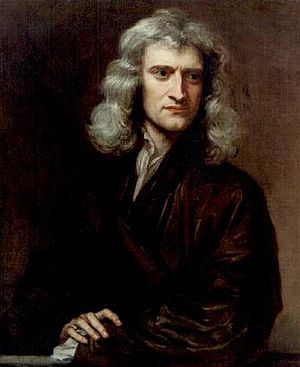
In 1687, the English mathematician Isaac Newton published a very important book called Principia. In it, he described his law of universal gravitation. Newton said that every object in the universe pulls on every other object. The strength of this pull depends on two things:
- The masses of the objects: Bigger objects pull more strongly.
- The distance between them: The closer they are, the stronger the pull.
Newton's theory was so good that it was used to predict the existence of the planet Neptune. Scientists noticed that Uranus's orbit wasn't quite right, and they realized another planet's gravity must be pulling on it.
However, Newton's theory wasn't perfect. Later, scientists found tiny mistakes when trying to explain the orbit of Mercury. These small errors were fixed by Albert Einstein's theory of General Relativity. Still, Newton's theory is often used today because it's simpler and accurate enough for many everyday calculations, like planning space missions within our Solar System.
Why Earth Doesn't Fall into the Sun
You might wonder why the Earth doesn't just fall into the Sun because of gravity. The answer is that the Earth is constantly moving around the Sun. This movement creates a force that balances the Sun's gravitational pull. It's like spinning a ball on a string: the string pulls the ball in, but the ball's motion keeps it from falling into your hand. This balance is called a dynamic equilibrium.
The Earth keeps spinning because there's almost nothing in space to stop it. Newton's first law of motion says that an object in motion will stay in motion at the same speed and direction unless an outside force acts on it.
Feeling Weightless
When you are in free fall (like on a roller coaster going down a big drop) or in orbit around Earth, you feel "weightless." This happens because your motion perfectly balances the pull of gravity. You are still being pulled by gravity, but you are constantly falling around the Earth instead of falling into it.
General Relativity
Albert Einstein's general theory of relativity is a much deeper way to understand gravity. Instead of gravity being a force, Einstein said that gravity is actually a bending or curving of spacetime. Spacetime is like a giant, invisible fabric that makes up our universe, combining space (length, width, height) and time.
Imagine placing a heavy bowling ball on a stretched rubber sheet. The bowling ball makes a dip in the sheet. If you then roll a marble nearby, it will curve towards the bowling ball, not because the bowling ball is pulling it directly, but because the sheet itself is curved.
In the same way, massive objects like planets and stars bend spacetime around them. Other objects, like light or smaller planets, then follow these curves in spacetime. So, spacetime tells matter how to move, and matter tells spacetime how to curve!
For everyday situations and within our Solar System, Einstein's theory gives almost the same answers as Newton's theory. That's why Newton's simpler equations are still useful. But for very strong gravity (like near black holes) or very precise measurements, Einstein's theory is needed.
General relativity has some amazing predictions:
Gravity Affects Time
Gravity can actually change how time passes!
- If light travels away from a massive object (like escaping a planet's gravity), its waves get stretched out, making it appear "redder" (this is called gravitational redshift).
- If light travels towards a massive object, its waves get squished, making it appear "bluer" (this is called gravitational blueshift).
More generally, clocks tick slower when they are closer to a massive object and faster when they are farther away. This effect is called gravitational time dilation. It's a real effect that needs to be accounted for in things like GPS satellites to make sure they work accurately!
Light Bends Around Massive Objects
General relativity predicts that light itself will bend when it passes near a massive object. This is because light follows the curves in spacetime. This was famously proven during a total solar eclipse in 1919. Scientists observed starlight bending as it passed close to the Sun, just as Einstein predicted.
Another related effect is the gravitational time delay. This means light signals take longer to travel through a gravitational field than they would in empty space. This has also been tested and confirmed many times.
Gravitational Waves
Einstein's theory also predicted the existence of gravitational waves. These are like ripples or waves in the fabric of spacetime itself. They are created by very powerful and violent events in space, like two black holes crashing into each other or giant stars exploding.
Gravitational waves travel outward from their source, carrying energy. They move at the speed of light. While they are incredibly hard to detect directly, scientists have found indirect evidence for them. In 2015, scientists at the LIGO observatory finally detected gravitational waves directly for the first time, confirming Einstein's prediction a century later!
Related pages
Images for kids
-
Artist's conception of gravity pulling mass away from a star and into a black hole
-
The Leaning Tower of Pisa, where Galileo performed one of the most famous experiments about the speed of falling objects
-
English physicist and mathematician, Sir Isaac Newton (1642–1727)
-
The 1919 total solar eclipse provided one of the first opportunities to test the predictions of general relativity
-
The LIGO Hanford Observatory located in Washington, United States, where gravitational waves were first observed in September 2015.
See also
 In Spanish: Gravedad para niños
In Spanish: Gravedad para niños




